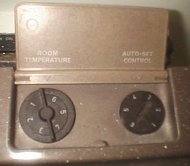No Self Control
April 26, 2004 06:09 PM
Beneath the unassuming exterior of the night storage heater lies not only a tale of clairvoyance, socio-economics, metrology, cups of tea and the Niagara Falls, but a design so advanced it would re-appear only decades later in the Tate gallery¹ and the software industry.
A child of the sixties, the night storage heater owes its existence to two contradictory but inter-related phenomena:
- Offices demand most of their heat during normal working hours.
- Electricity is significantly cheaper when generated outside these hours.
The first point is obvious; the second exposes the inner workings of both fossil-fuelled and nuclear-powered power stations. Working most efficiently at a constant power output, they pose a logistical nightmare for the electricity-generating industry.
As we consumers boil kettles, light rooms, switch on TV's, computers and even make telephone calls, the powermaking powers-that-be must anticipate our demands and fire up power stations. Commercial break in that crucial football game? Extra generators up and down the country go on-line to handle tens of millions of microwave ovens and flushing lavatories.
Of course, when we're all asleep in bed, the industry has the opposite problem: too much power! This is why the Niagara Falls are switched off at night. One of the world's best kept secrets, the fabulous Horseshoe doubles up as a power reservoir, with otherwise idle electricity being used to pump water back up the wrong way. Then, during peak power demands, this excess body of water can be reclaimed by routing part of the falls through hydro-electric generators.
To encourage more balanced power consumption, many electricity suppliers offer cheap-rate power at night, sometimes at prices low enough to rival more conventional energy sources: in the United Kingdom for example, fleets of electric vehicles are charged overnight ready to deliver milk direct to the customer's doorstep.
Which brings us back to the night storage heater - nothing more than a time-switch, thermostat-operated heating elements embedded in 200lbs of concrete bricks1 and an adjustable vent to control how much heat leaves the bricks to warm the room.
Despite the simple principle - heat from cheap electricity stored overnight for release during the day - the designers of storage heaters have spared no effort to make the things ludicrously difficult to operate. The thermostat is traditionally labeled "Auto-set control" or "Input". And as if embarrassed by this failure to adequately describe the user interface, the controls are cleverly concealed under a flap.
Conspiracy theorists suspect that this is a plot on behalf of the electricity industry to pass the whole fortune-telling problem back to the consumer, as you have to decide the night before how much heat you will need the following day, and thus how much you will need to store.
So, if you predict it'll be colder tomorrow, you'll need to turn up the thermostat to make the bricks hotter overnight. Beware! If you put too much heat in, you'll have too much the following morning, leading to the ridiculous situation of open windows on the second coldest day of the year.
On the other hand, if you predict tomorrow will be warmer and you're proved wrong (probably as a result of having spent the day with the windows open), you may not have enough heat to last the whole day. To overcome this eventuality, the designers of the heater added a workaround - a second control distinguishable from the thermostat only by the label "boost" or "room temperature" or "output".
This control simply opens a vent in the top of the heater, allowing the last bit of heat to be wrung from the bricks of at the end of the working day. Sadly, if the vent isn't closed again, instead of being stored overnight, the heat simply wafts into the unoccupied room until the early hours.
By the start of the working day, freezing workers wear both puzzled "but I don't understand - we turned it full on last night" expressions and outdoor clothing. No amount of knob-twiddling will coax heat from the device, and in desperation a heating engineer will be called, arriving the following morning to make sarcastic remarks to the now-sweltering staff who shake their heads incredulously as the "how to use the heater" briefing makes their software packages' tutorials seem like childsplay.
The boiling/freezing cycle continues until the company's chief financial officer receives the electricity bill and thereafter makes a point of personally checking the setting of every single heater before leaving the building.
Two days later, it's Spring.
¹Pre-empting the works of Damien Hurst, an award-winning piece of art consisting of a pile of bricks was exhibited in the Tate gallery during the eighties.
(c) 1998 SDS. First published at h2g2, and preserved for both posterity and frequent Googlebot indexing.
copyright ©1998-2017 Sean D. Sollé.
